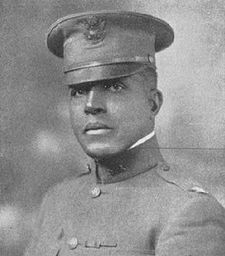Charles Young (United States Army)
| Charles Young | |
|---|---|
 |
|
| Born |
March 12, 1864 Mays Lick, Kentucky |
| Died | January 8, 1922 (aged 57) Nigeria |
| Buried at | Arlington National Cemetery |
| Allegiance | United States of America |
| Years of service | 1889–1922 |
| Rank | Colonel |
| Unit | 9th Cavalry Regiment |
| Commands held | 10th Cavalry Regiment |
| Battles/wars |
Indian Wars Spanish–American War Philippine–American War Pancho Villa Expedition World War I |
Charles Young (March 12, 1864 – January 8, 1922) was the third African-American graduate of West Point, the first black U.S. national park superintendent, first black military attaché, first black man to achieve the rank of colonel, and highest-ranking black officer in the Regular Army until his death in 1922.
Charles Young was born in 1864 into slavery to Gabriel Young and Arminta Bruen in Mays Lick, Kentucky, a small village near Maysville. However, his father escaped from slavery early in 1865, crossing the Ohio River to Ripley, Ohio, and enlisting in the Fifth Regiment of Colored Artillery (Heavy) near the end of the American Civil War. His service earned Gabriel and his wife their freedom, which was guaranteed by the 13th Amendment after the war. Arminta already knew how to read and write, which suggests she may have worked as a house slave before her freedom. The Young family settled in Ripley when Gabriel was discharged in 1866, deciding that opportunities were probably better there than in postwar Kentucky. Gabriel Young received a bonus by continuing to serve in the Army after the war, and he had enough to buy land and build a house.
Charles Young attended the all-white high school in Ripley, the only one there who was Afro-American. He graduated in 1880 at the top of his class. He then taught school for several years in the new black high school that was opened in Ripley.
In 1883, Young took a competitive examination for appointment as a cadet at United States Military Academy at West Point. He had the second highest score in his district, but the top candidate decided not to go and Young reported to West Point in 1884. There was then one other black cadet, John Hanks Alexander, who had entered in 1883 and graduated in 1887. Young and Alexander shared a room for three years at West Point. Although regularly discriminated against, Young did make several lifelong friends among his later classmates. He had to repeat his first year when he failed mathematics. He later failed an engineering class, but he passed it the second time when he was tutored during the summer by George Washington Goethals, the Army engineer who later directed construction of the Panama Canal and who as an assistant professor took an interest in Young. (It was not unusual for cadets to need tutoring in some subjects. Young's strength was in languages, and he learned to speak several.)
...
Wikipedia
